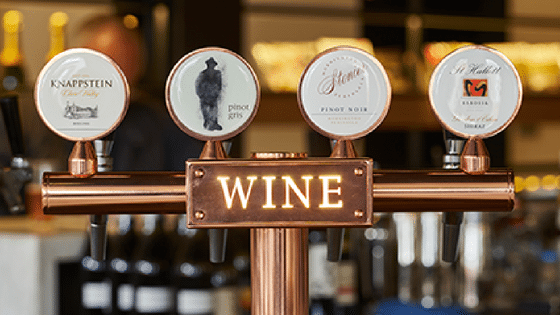Wine on tap or keg wine is slowly gaining momentum in Australia. Is it just a fad, or an innovation that will change the way we drink wine? We look at the benefits of wine on tap for both venues and consumers.
Perceptions of wine on tap
Ask most people what they think of wine on tap and their answer will probably be:
- Never heard of it.
- Is that a thing?
- It’s probably cheap, poor quality wine.
Since the early days of wine on tap in the US some 30 years ago, there have been some big improvements in wine kegs and dispensing systems. Furthermore, wine producers are working with venues to provide higher quality wines for the wine on tap system.
Wine on tap systems
Wine on tap systems start with the wine being provided in stainless steel kegs or pressurised bladders. Stainless steel kegs are the more popular option, probably because they hold larger volumes.
Before the stainless steel keg is filled with wine, it needs to be purged of oxygen (usually with nitrogen) to prevent oxidation and spoilage of the wine. Being an inert gas, nitrogen is the preferred gas to use because it is colourless and odourless and won’t react with the wine. Importantly, it won’t spoil the wine and change its taste or make it fizzy.
Once the keg is purged of oxygen it is ready to be filled with wine. The headspace between the wine and the top of the keg must also be purged of oxygen. After this step, the keg is pressurised in readiness for serving via the tap.
The most common tap systems look the same as those used for draught beer. Where white and red wines are on tap, the dispensing system must regulate the temperature for each (around 45°F for Whites and 55-60°F for Reds).
Wine lines, keg couplers, and tap fittings should be cleaned regularly with the right mix of chemicals to remove mineral deposits or bio-films that can build-up and taint the wine.
Benefits of wine on tap
For venues, the benefits of wine on tap are impressive.
- The wine never comes into contact with air, which means:
- no risk of spoilage or oxidation.
- preservation of the full flavours and freshness of the wine.
- Ability to consistently pour flawless wine from the first to last glass, reducing costs associated with wastage.
- No risk of cork taint.
- Ability to source and sell good quality wines at a cheaper price than the bottled version.
- Less storage space required – a 50L Keg = 65 bottles of wine.
- Reduced costs and carbon footprint.
- Less handling and transportation.
- Less packaging going to landfill.
- Stainless steel wine kegs are refillable for up to 30 years.
For consumers, the benefits of wine on tap include:
- Better quality wines available by the glass at a cheaper price than the bottle price.
- Greater choice of quality wines available by the glass.
- Consistent quality, glass after glass.
- Less risk of being served wine that has oxidised.
Where to now – Educating consumers
For venues considering incorporating a wine on tap system into their beverage strategy, they will also need to put a plan in place for educating consumers on the benefits. Educating and training staff is crucial to winning customers over. And of course, the wine on tap must be good quality.
Service starts here
Members of our team have been working in the hospitality industry for more than 20 years. If you have any questions on products or chemicals related to wine on tap systems, please let us know. We can help you choose the right hospitality supplies.
Please feel free to call us on (02) 9052 9111

